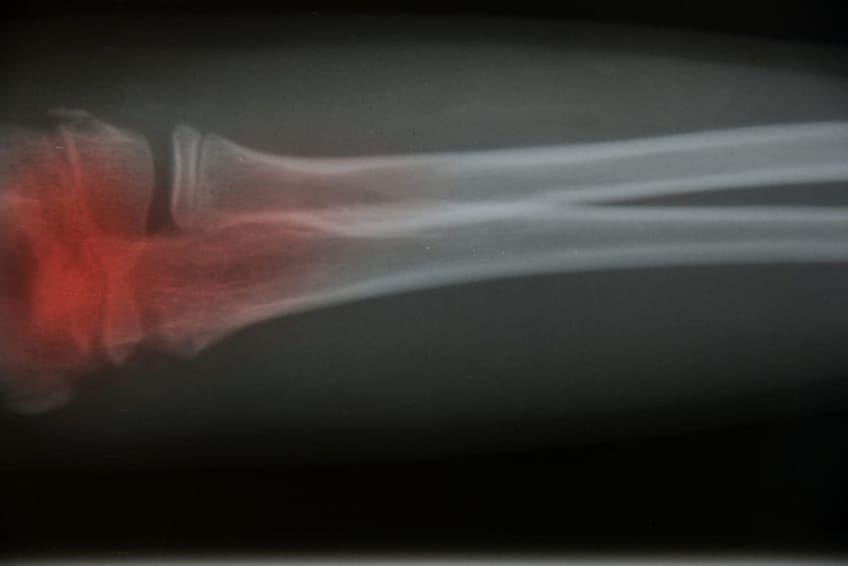
Bone cancer is a rare but serious condition that starts in the cells of your bones. Knowing the common bone cancer symptoms and treatment options can help you recognize warning signs early and get the right care. With early diagnosis and a personalized treatment plan, many people can manage the condition and improve their quality of life.
What is bone cancer?
Bone cancer is cancer of the bones. It can begin as a tumor in a bone or it can spread to the bone from another area. Most cases of bone cancer start in other areas. When the cancer spreads to the bones, it is called metastatic cancer, or secondary cancer. It is rare for cancer to start in a person’s bones.
Bone cancer consists of cancerous (malignant) tumors. These destroy bone tissue and can continue to spread. Noncancerous (benign) tumors are often not life threatening but can still cause damage to your bones.
There are three main forms of bone cancer.
- Osteosarcoma occurs in the hard (osteoid) bone tissue. Most often, it is found in your thighbone just above your knee or in your upper arm. It typically affects children and teens under the age of 19 or people over the age of 65.
- Chondrosarcoma occurs in cartilage. Cartilage is the tissue that connects and pads your bones and joints. Most often, this type is found in your shoulder, upper leg, or hips. It typically affects adults over the age of 40.
- Ewing sarcoma occurs in bone or surrounding soft tissue. Most often, it is found in your arms, legs, pelvis, or backbone. It typically affects children and teens, especially boys, under the age of 19.
Chordoma is another kind of bone cancer that is very rare and forms in the spine. This cancer is more common in men than women, and typically occurs in older adults.
Symptoms of bone cancer
The main symptom of bone cancer is pain. However, not everyone has pain. You also may have swelling in the area where bone cancer exists, fractures, or high levels of calcium in the blood. Other symptoms include:
- A soft, warm lump in the arms, legs, chest, or pelvis
- Unexplained fever
- Bones that break for no known reason
What causes bone cancer?
There are several causes of bone cancer. Many times, cancer from another part of your body spreads to your bones. This is more likely to occur in people who have had radiation or chemotherapy. Children are more vulnerable to this.
Other less common causes include:
- Family history of bone cancer
- Bone defects
- Metal implants (this is extremely rare)
In some cases, the cause of bone cancer is unknown.
How is bone cancer diagnosed?
There are several tests your doctor may do to look for and diagnose bone cancer. If the doctor finds a tumor, they will need to find out if it is cancerous or not. These tests may include:
- X-rays
- Magnetic resonance imaging (MRI)
- Computed tomography (CT) scan
- Bone scan
- Biopsy
- Blood tests
Can bone cancer be prevented or avoided?
In general, bone cancer cannot be prevented or avoided.
Bone cancer treatment
Treatment options vary based on the type of bone cancer, the size, and the location. They also depend on your age and overall health. Surgery is the most common form of treatment. The goal is to remove the entire tumor. In some cases, this may require amputation of your arm or leg.
In place of surgery, the doctor may recommend cryosurgery. This treatment uses liquid nitrogen to freeze and kill the tumor and cancer cells. Chemotherapy and radiation therapy are other forms of treatment. Chemotherapy uses medicine to stop the growth of cancer cells. It can be given by mouth, injection (shot), infusion (through an IV) or even on the skin. Radiation uses high-energy rays to kill cancer cells.
Some types of treatment will require physical therapy or rehabilitation. Your doctor also may recommend certain lifestyle changes.
Living with bone cancer
After treatment, it is important for you to have routine visits with your doctor. This can help to identify problems right away. Once bone cancer is removed, it can still come back or spread. You also may develop other types of cancer or health problems. Tell your doctor about any new symptoms you have.
Questions to ask your doctor
- What type of bone cancer do I have?
- Is it life-threatening or dangerous?
- How big is the tumor and where?
- What caused my bone cancer?
- What are my treatment options?
- What is the chance of bone cancer coming back or getting another form of cancer?
Resources
![]()
Copyright © American Academy of Family Physicians
This information provides a general overview and may not apply to everyone. Talk to your family doctor to find out if this information applies to you and to get more information on this subject.







